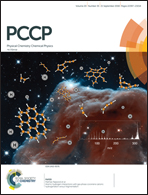A computational study of the Fenton reaction in different pH ranges†
Abstract
The reaction of iron(II) and hydrogen peroxide, namely the Fenton reaction, is well-known for its strong oxidizing capability. While the Fenton reactions are ubiquitous and have wide applications in many areas, the detailed mechanism, especially the nature of the reactive intermediates responsible for oxidation, is not completely clear. In this work, the performances of various density functional theory (DFT) methods on the relative energies of key Fenton intermediates are evaluated. The DFT method selected from the benchmark study is then exploited to investigate the aqueous Fenton reactions in different pH conditions. The results show that at pH > 2.2, the major Fenton oxidants are high-valent oxoiron(IV) aquo complexes. However, depending on the pH conditions, these complexes can exist in three protonation states that display quite different oxidation reactivities. The oxidizing power of FeIV![[double bond, length as m-dash]](https://www.rsc.org/images/entities/char_e001.gif) O is found to be principally determined by the total charge of the ligands and is less influenced by the axial ligand effect. Moreover, the calculations reveal that the presence of the hydronium ion can stabilize the intermediate of the hydroxyl radical and further inhibit oxoiron(IV) formation via proton transfer. The contribution of hydroxyl radicals could compete with the oxoiron(IV) species at pH below 2.2. In addition, high-level ab initio calculations question the existence of the iron(IV)-dihydroxo intermediate suggested in the literature. The implications of the computational results for the Fenton oxidation process, cytochrome P450, and catalyst design are discussed.
O is found to be principally determined by the total charge of the ligands and is less influenced by the axial ligand effect. Moreover, the calculations reveal that the presence of the hydronium ion can stabilize the intermediate of the hydroxyl radical and further inhibit oxoiron(IV) formation via proton transfer. The contribution of hydroxyl radicals could compete with the oxoiron(IV) species at pH below 2.2. In addition, high-level ab initio calculations question the existence of the iron(IV)-dihydroxo intermediate suggested in the literature. The implications of the computational results for the Fenton oxidation process, cytochrome P450, and catalyst design are discussed.



 Please wait while we load your content...
Please wait while we load your content...